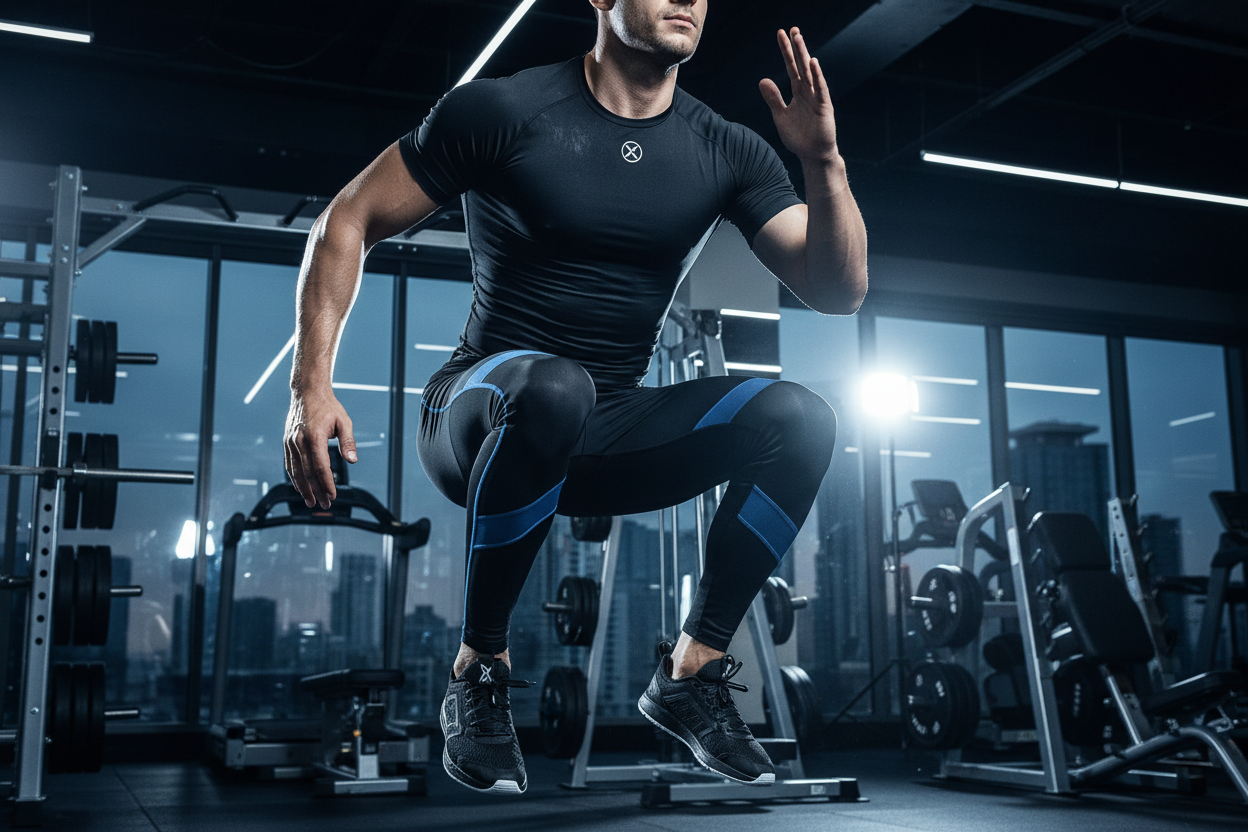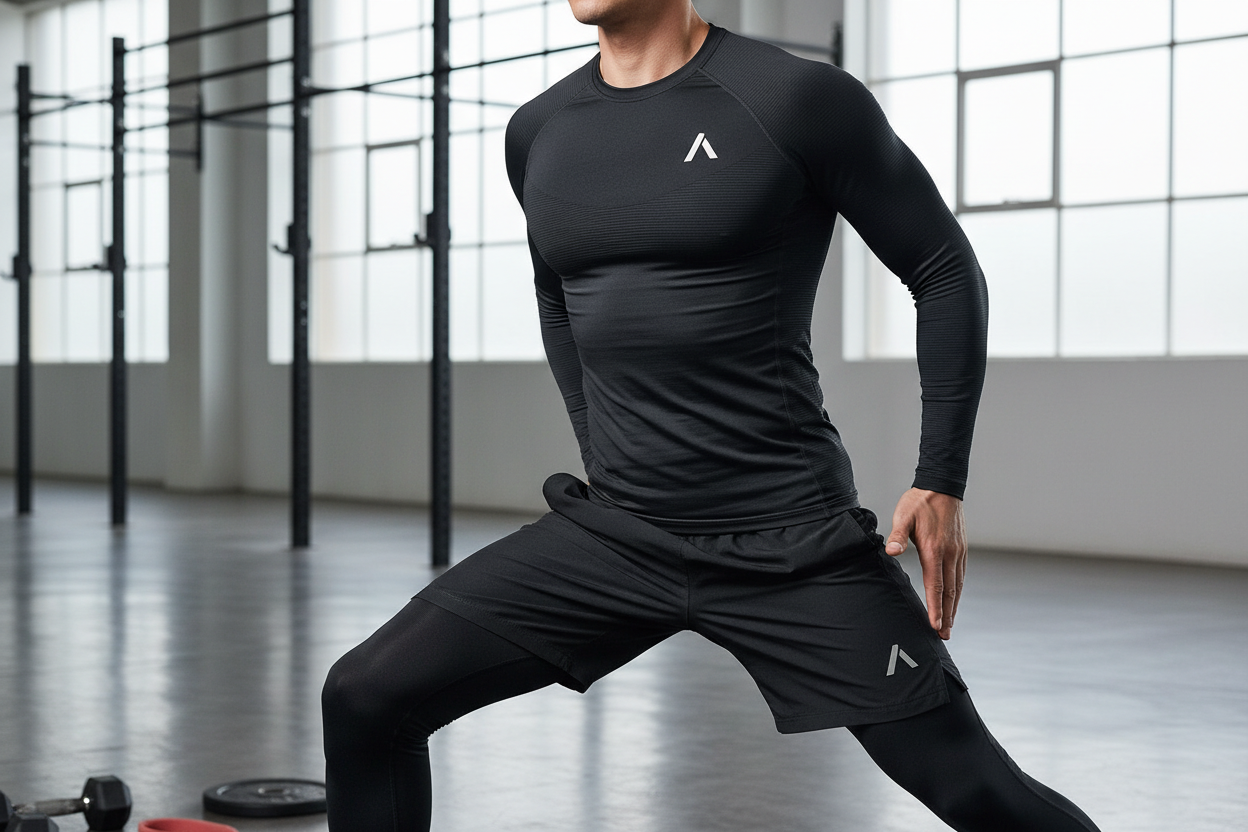Whether you’re a serious athlete, a fitness enthusiast, or someone who spends long hours on their feet, compression gear has become more than just a trend it’s a performance and recovery tool rooted in science. At Myovv, our compression wear collection is designed to support blood flow, reduce muscle vibration, promote faster recovery, and improve comfort.
1. What Is Compression Gear?
Compression gear refers to tight-fitting garments made from elastic materials (like spandex, elastane, nylon) designed to apply a controlled pressure to the body. Unlike loose workout clothes, compression gear is engineered to perform specific functions:
- Provide graduated pressure typically tighter at the extremities (ankles, wrists) and gradually decreasing upward.
- Improve blood circulation and venous return.
- Stabilize muscles during movement.
- Reduce muscle oscillation (vibration) during high-impact activities.
- Support recovery by helping flush metabolic waste.
- Enhance proprioception (body awareness).
Common forms of compression gear include:
- Compression leggings / tights
- Compression shorts
- Compression tops / shirts
- Compression sleeves (arms or calves)
- Compression socks and stockings
- Full-body compression suits
Compression gear started in the medical field (for conditions like deep vein thrombosis). Over time, athletes adopted it for its performance and recovery benefits, and now it's mainstream in sports, fitness, and even daily wellness.

2. How Compression Works: The Science Behind It
To appreciate the value of compression gear, it’s helpful to understand how it works on a physiological level. Here are the main mechanisms:
a) Improved Blood Flow & Venous Return
Compression gear exerts external pressure on the limbs, especially the lower legs, which helps blood flow more efficiently back toward the heart. This “venous return” effect is a primary driver of many compression benefits. A systematic review and meta-analysis found that compression garments significantly improve overall peripheral blood flow, especially venous flow, during and after exercise.
b) Muscle Stabilization & Reduced Oscillation
When you run, jump, or move dynamically, your muscles vibrate (oscillate). These tiny vibrations can contribute to fatigue, microdamage, and inefficiency. Compression reduces this muscle oscillation, helping stabilize tissue, which may improve performance and reduce fatigue.
c) Enhanced Recovery Through Metabolite Clearance
By optimizing blood flow, compression gear may help clear metabolic by products such as lactate more quickly. This supports faster recovery and reduces soreness. Research through meta-analysis suggests benefits for strength, power, and endurance recovery.
d) Increased Proprioception
Compression garments provide feedback to your muscles and joints, improving your body’s awareness of movement. This can help with balance, stability, and coordination.
e) Thermal Regulation
Compression gear can influence skin temperature, sweating, and heat dissipation. Depending on fabric and design, it can help regulate temperature during activity. That said, in some settings, compression may impair cooling by reducing evaporative sweat loss.
3. Research-Backed Benefits of Compression Gear
Let’s dive into what scientific research says about the benefits of compression gear performance, recovery, blood flow, and more.
3.1 Performance Improvements
- A meta-analysis published in Applied Sciences found that wearing compression sportswear significantly improved speed, endurance, and functional motor performance.
- In elite or well-trained populations, whole-body compression suits were especially effective for speed, while lower-body compression worked well for endurance.
- A study on rugby players showed that wearing compression garments for 24 hours post exercise (during recovery) led to better sprint and endurance performance the next day, compared to placebo garments.
3.2 Enhanced Recovery & Reduced Muscle Soreness
- The meta analysis of 23 studies (healthy participants) found that compression garments produced small but very likely benefits in recovery metrics (strength, power, endurance) across different time points (post-exercise)
- A specific study with consecutive day, high-intensity intermittent exercise (e.g., team sports) showed compression didn’t change blood lactate or creatine kinase significantly, but perceived muscle soreness was lower.
- For cyclists, wearing lower-body compression garments during recovery (24 h) improved performance on a subsequent 40-km time trial, compared with a non-compression placebo garment.
3.3 Improved Circulation & Blood Flow
- A 2023 meta-analysis of 22 studies found that sports compression garments improve both venous and arterial peripheral blood flow during exercise or physiological challenges.
- In a study of male basketball players, compression tights, shorts, and socks all increased markers of venous return, muscle blood flow, and muscle oxygenation at rest with tights showing the strongest effect.
3.4 Practical & Psychological Benefits
- Compression gear can support technique and neuromuscular efficiency through enhanced proprioception and muscle stabilization.
- Psychological and perceptual benefits: Some users report that compression gear makes them feel more supported or ready, which can positively affect performance and recovery.
3.5 Caveats and Nuanced Findings
- A recent controlled trial examined compression tights worn for 5 hours post-resistance exercise. It found no significant effect on muscle protein synthesis, blood flow, or performance recovery measures compared to no compression.
- Another concern: in some environmental conditions (like warm settings), compression may impair cooling during exercise by reducing sweat evaporation.

4. Types of Compression Gear & When to Use Them
Compression gear comes in many forms. Depending on your goals performance, recovery, travel, daily wear different types may be more suitable.
4.1 Compression Leggings / Tights
- Provide full support for quads, hamstrings, glutes, and calves.
- Ideal for running, weight training, HIIT, or as recovery wear.
4.2 Compression Shorts
- Focused on lower body (thighs, glutes) without full leg coverage.
- Useful in warm weather, for sprinting, or strength training.
4.3 Compression Tops / Shirts
- Provide stability and support for the torso, upper back, and arms.
- Good for lifting, running, or layered under other clothes.
4.4 Compression Sleeves
- Available for calves or arms.
- Great when you want targeted compression for specific muscle groups.
4.5 Compression Socks / Stockings
- One of the most common forms.
- Use for travel (long flights), standing or sitting jobs, running, or post workout recovery.
4.6 Full-Body Compression Suits
- Provide compression across a larger body area.
- Popular in endurance sports, cycling, or for total-body recovery.

5. Who Benefits Most from Compression Gear?
While nearly anyone can benefit, certain groups gain more:
- Athletes & Fitness Enthusiasts: For performance gains and faster recovery.
- Endurance Athletes: Runners, cyclists, triathletes benefit from better blood flow and reduced muscle fatigue.
- Strength Athletes: Weightlifters and cross trainers who want muscle support and stability.
- Team Sport Players: For repeated sprint or intermittent-exercise recovery.
- Travelers: Compression socks can reduce leg swelling and risk during flights or long drives.
- Professionals Standing or Sitting: Office workers, nurses, retail staff can reduce leg fatigue and fluid buildup.
- Recovery-Focused Individuals: People who want to maximize recovery from consistent training.
- People with Mild Circulatory Concerns: While compression gear isn’t a direct replacement for medical treatment, moderate compression can help circulation but always consult a medical professional if needed.
6. How to Choose the Right Compression Gear (with Myovv in Mind)
Picking the right compression gear is important to get real benefits. Here’s what you should consider:
a) Compression Pressure (“Level” / mmHg)
- Compression gear is often rated by pressure (in mmHg).
- For athletic or recovery use, moderate compression (e.g., 15–20 mmHg) is often very effective.
- Higher compression (medical grade) is reserved for medical needs and should be selected carefully.
b) Fit & Sizing
- Compression only works if the garment fits properly: too loose no benefit; too tight discomfort or restricted circulation.
- Use sizing charts. Measure calves, thighs, or other relevant parts.
- Consider the garment’s elasticity and how much it will stretch.
c) Material & Fabric
- Look for breathable, moisture wicking materials (e.g., nylon, spandex, elastane) these keep you dry and comfortable.
- Durable fabrics are important: compression garments should retain their elasticity after many washes.
- Seam construction matters flat seams or seamless designs reduce chafing.
d) Design & Purpose
- Match the garment to your use:
· Performance: leggings, sleeves, shorts
· Recovery: tights, full suits
· Everyday/Travel: socks, stockings
- For multi purpose use, go for versatile designs that are comfortable enough for long wear.
e) Comfort & Aesthetics
- Choose a balance between function and style compression doesn’t have to look clinical.
- Consider fabric stretch, how snug it feels, and the garment’s look.
f) Durability & Longevity
- Compression gear should maintain its tightness and shape through repeated wear.
- Evaluate fabric quality, reviews, and garment care instructions.

7. How to Use Compression Gear Effectively
To maximize the benefits of compression gear, follow these practical tips:
During Training
· Wear compression leggings, tops, or sleeves during workouts to provide muscle support and reduce vibration.
· For endurance sessions, compression socks may help maintain circulation.
Post Exercise Recovery
· Use compression wear for 1–4 hours after training or competition to support recovery. Studies show this helps with metabolite clearance and muscle soreness.
· Change into clean compression gear after a workout for better hygiene and comfort.
During Travel or Long Periods of Inactivity
· Wear compression socks or leggings during long flights or road trips to reduce swelling and promote circulation.
Everyday Use
· If you sit or stand for many hours daily, wearing lighter compression garments (like socks or leggings) can help support vascular health and reduce fatigue.
Consistent Use
· Regular use (especially for recovery) gives more benefit than sporadic use.
· Consider having more than one pair so you can rotate and allow the elasticity of each garment to recover.
8. Potential Drawbacks & Precautions
While compression gear is generally safe, there are some important caveats:
-
Discomfort from Too-Tight Gear
Wearing excessively tight compression gear can lead to restricted blood flow or even numbness. -
Skin Irritation
Poorly fitting seams, or non-breathable fabric, can irritate skin. -
Overreliance
Compression gear is a tool not a substitute for sleep, nutrition, or proper recovery strategies. -
Medical Conditions
If you have vascular or circulatory conditions (e.g., deep vein thrombosis, varicose veins), consult a healthcare professional before using compression garments. -
Environmental Factors
In very hot environments, compression may impair cooling due to reduced evaporative sweat loss. -
No Guaranteed Molecular Signaling Effects
Some research (e.g., on muscle protein synthesis) shows little to no effect, so don’t expect compression to dramatically alter anabolic signaling.
9. How to Care for Compression Gear
Proper care ensures longevity and sustained performance of compression garments:
- Washing: Use cold water, mild detergent, gentle cycle; avoid chlorine bleach, fabric softeners, or harsh chemicals.
- Drying: Air-dry flat or hung, away from direct heat or sunlight (heat can degrade elastic fibers).
- Replacement: Over time, elastane or spandex fibers lose their elasticity replace when they no longer provide adequate compression or feel loose.
-
Rotate: Having more than one garment helps preserve elasticity, as alternating wear & washing reduces strain on fibers.

10. Why Choose Myovv Compression Gear
At Myovv, we believe compression gear should be more than just functional it should be quality, comfortable, and stylish. Here’s why Myovv’s compression wear stands out:
- Premium, High-Performance Fabrics: We use durable, breathable materials that maintain compression even after repeated use.
- Balanced Compression Design: Our garments are engineered for effective pressure distribution tight enough to help, but not so tight that they’re uncomfortable.
- Versatile Styles: Myovv offers a full range leggings, shorts, tops, sleeves, socks covering performance, recovery, and daily wear.
- Durable Construction: Thoughtful seam design, quality stitching, and resilient fabric mean our gear lasts.
- Comfort-Driven: Seamless or flat-seam options reduce irritation; ergonomic fits improve wearability.
- Research-Backed Performance: We design our gear informed by scientific insights into circulation, recovery, and muscular mechanics.
Explore our full compression wear collection here: Myovv Compression Wear
11. Real-World Use Cases & Scenarios
Here are examples of how people use compression gear in real life:
-
Endurance Training
A cyclist wears compression leggings during long rides, and then switches to compression socks or tights afterward to speed up recovery. -
High Intensity Workouts
A gym-goer wears compression shorts or tops during HIIT sessions to stabilize muscles and reduce vibration. After training, they continue wearing compression garments for a few hours to promote recovery. -
Team Sports
A rugby or basketball player wears compression tights or sleeves during and after games to reduce soreness and improve next-day performance. -
Long Flights or Travel
A frequent traveler wears graduated compression socks on flights to prevent swelling and maintain circulation. -
Long Work Days
Someone in a job that requires standing all day (e.g., retail, healthcare) uses compression leggings to reduce leg fatigue. -
Daily Recovery
A fitness enthusiast uses compression gear after training sessions, combined with rest, proper nutrition, and hydration, to optimize muscle recovery.
12. Frequently Asked Questions (FAQ)
Q: Does compression gear make me run faster?
A: Research shows small but significant improvements in speed and endurance, especially for moderately trained individuals.
Q: Will compression garments completely eliminate muscle soreness?
A: No. While compression helps reduce soreness and markers of muscle damage, it’s not a magic cure. Combine it with rest, nutrition, and sleep for best recovery.
Q: How tight should compression gear be?
A: It should feel snug but not painful. If you feel numbness or tingling, it may be too tight.
Q: How long do I wear compression gear after exercise?
A: Many benefits are observed when compression is worn for 1–4 hours post-exercise, though some people wear it longer for recovery.
Q: Can I wear compression gear every day?
A: Yes, especially lighter compression leggings or socks. But make sure to rotate garments and wash them properly.
Q: Is compression gear safe for medical conditions?
A: If you have circulatory or vascular issues (e.g., DVT), consult a healthcare provider before using compression gear.
13. Conclusion
Compression gear is not just a fitness fad it’s a scientifically grounded tool that can improve performance, support recovery, and enhance daily comfort. Whether you’re a high-performance athlete, someone recovering after hard workouts, or just starting your fitness journey, the right compression garments can make a meaningful difference.
At Myovv, our compression wear is built with your goals in mind: performance, style, durability, and comfort. By understanding how compression works, choosing the right gear, and using it smartly, you unlock real benefits validated by research.
Explore Myovv’s full compression wear collection today and feel the power of support, performance, and recovery all in one piece.
Research References
- Weakley J, Broatch J, O’Riordan S, et al. Do Sports Compression Garments Alter Measures of Peripheral Blood Flow? A Systematic Review with Meta-Analysis. Journal of Sport & Health Science. 2023.
- Yang J, Redding E, Qiu C. Compression Sportswear Improves Speed, Endurance, and Functional Motor Performances: A Meta-Analysis. Applied Sciences. 2021.
- Kraemer WJ, et al. Effect of Compression Garments on Short-Term Recovery: Rugby Study. Journal of Strength & Conditioning Research. (via Lippincott) URL & details: compression after high-intensity exercise improved next-day sprint and endurance.
- Berry MJ, McMurray RG, Parker BA. Positive effect of lower body compression garments on subsequent 40-km cycling time trial performance. Journal of Strength & Conditioning Research, 2012.
- Hill JA, Howatson G, Fallowfield JL, et al. Compression Garments and Recovery from Exercise: A Meta-Analysis. Medicine & Science in Sports & Exercise.
- Bringard A, Perrey S, Belluye N. (Related concepts muscle stabilization and blood flow) discussed in review.
- Beliard S, Dupont C, et al. Sports compression garments improve resting markers of venous return and muscle blood flow in basketball players.
- Kraemer WJ, Ratamess NA, et al. The Acute Effects of Compression Garments on Muscle Protein Synthesis Markers, Blood Flow…
- Latif V., Amjad R., Mustafa M. Compression garments optimising performance, recovery and well-being. Journal of the Pakistan Medical Association.



Leave a comment
This site is protected by hCaptcha and the hCaptcha Privacy Policy and Terms of Service apply.